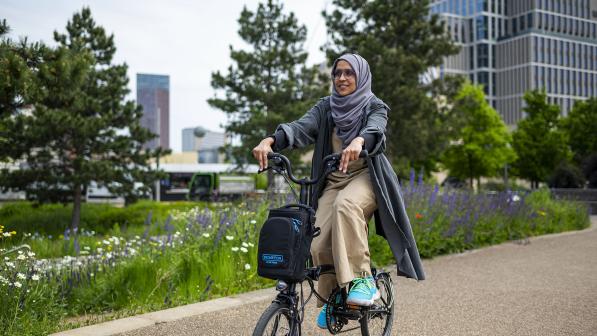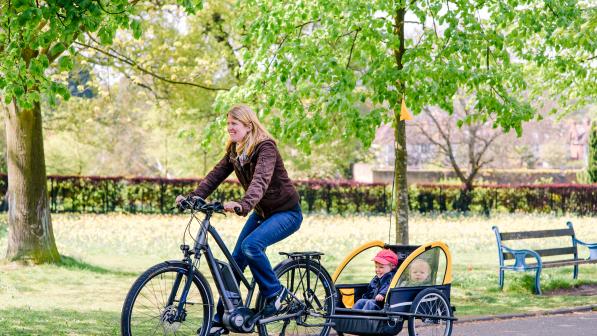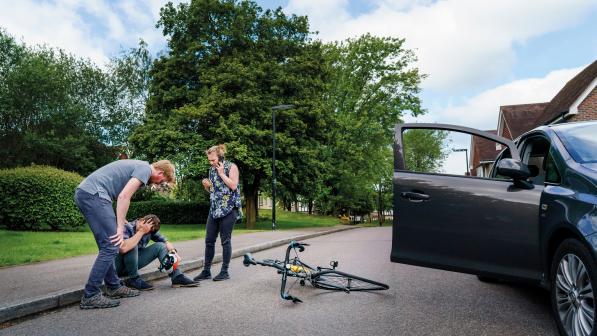How to get back into cycling after an injury

Being forced off your cycle because of injury is frustrating. I know this from personal experience, having fallen off my bike in 2016 and injuring my knee badly (the bike was fine, before you ask). I was signed off work and could barely get off the sofa, never mind back on my beloved bike.
Injuries, both cycling and non-cycling related, happen and some will mean that you can’t cycle until you’re fully healed. But if you’re anything like me you’ll be raring to get back out there. So when should you get back on your bike after an injury?
Keep in mind that there are no hard and fast rules here. What you’re capable of will depend on the type of cycling you do, how fit you were prior to the injury and even the type of injury. That said, there are guidelines that can help everyone.
There are broadly two types of injury: overuse and traumatic. The former, as the name suggests, is when a part of the body is being overused and can’t cope. Cycling is a very repetitive activity and sometimes the body simply can’t cope with those repetitive demands, which is when injury can occur. Your best option here is to rest until your body recovers.
The second type is caused by some sort of trauma. This is usually a collision or fall; injuries of this kind can vary from minor to very serious. It’s this sort of injury that will be dealt with here.
Again, there are two elements to consider: physical and psychological. You are the best judge of when you are ready to return to cycling and you should take into account both aspects. You should also consult healthcare professionals and work with your doctors. Talk to your GP to get their advice.
Time heals
The first thing to keep in mind is that your body needs rest and recuperation to heal. This takes time. Your body requires a lot of energy to heal, and it’s important that you give it the time and fuel to do this.
Retired GP and keen cyclist Dr Kate Brodie says: “After an injury you will be told by your team (doctor, nurse or physio) to rest to allow healing. This is important and may be for a week or a month or longer.”
The first few weeks are particularly vital for the healing process, as the injured site is often fragile while your body repairs itself. Patience is essential: the quickest way back to full power is to recover correctly the first time. If you start cycling before you’re fully recovered, you risk aggravating the injury and making it worse.
Dr Brodie advises: “Ask how long before you can start mobilising safely, and whether there are exercises you can do to strengthen the muscles and maintain your fitness meanwhile. Practise these regularly while you are unable to cycle.”
Take it slowly
It’s important to not overdo things – especially at the beginning. If you’ve had an enforced break from cycling, you will have lost fitness. But don’t panic; you won’t have gone back to square one. The important thing is to rebuild your fitness slowly.
Gillian, a newly qualified physiotherapist working for the NHS, says: “For traumatic injuries such as collisions, take it slowly and build back up to the level that you were at prior to the injury.
“A physiotherapist will help with this by assessing the injury and treating the specific issues that you are struggling with, for example reduced strength or tightness, with a tailored treatment plan which will take into consideration the goal of getting back onto the bike and back to the fitness and performance level that they were at prior to the injury.”
Your fitness will start to drop even after just a week of rest. You’ll first lose top-end speed and aerobic fitness. After a week or two you’ll start to lose endurance too. But after that the rate of decline will slow down.
Don’t despair, though. You won’t be starting from scratch. Some research shows that your muscles retain their adaptations to training for quite some time in both men and women, which can mean a faster return to cycling.
Dr Brodie again: “Depending on the nature of the injury, you may soon be able to cycle on a static bike or with your road bike on a turbo. If so, make sure it is secure and start gently at low resistance. “Build up from 5 minutes at a time by adding a few minutes each day until you can manage 30-60 minutes at a time. Increase the resistance to make it an effort as this will improve your cardiovascular fitness.
“If you experience pain from your injured part, or if your breathing is uncomfortable from the exertion slow down and ease up. You may be pushing too hard too soon. Be patient!
“Once you are given the green light to resume road cycling take the same approach. Start with short rides on a level route and gradually build up both the length and difficulty of the ride. If you are finding it hard repeat the same route until it becomes easier.”
Split training can help here. Instead of aiming for a 60-minute ride, do a 35-minute one early in the day and then a 25-minute one later on. The reason for the longer ride in the morning is that your body has had more time to heal overnight. If you feel any pain or tiredness, you can always skip the second ride, knowing that you’ve already had a decent ride that morning.
It’s important to know your own limits. But also keep in mind that it’s normal to feel some stiffness, especially if you haven’t exercised for a while.

Get motivated
However keen you are to get back on your bike, there will still be days when you just don’t feel like it. On those days you might need some extra motivation to get out there. Working out a realistic training plan can help with this – especially if you train with a friend, giving you a bit of accountability.
The key word here is realistic. If you set yourself overly ambitious goals you’re likely to miss them and that’s demoralising. Instead be honest with yourself about what you can achieve and gradually increase first the frequency and then the duration of your rides.
Printing off your plan or writing it out long hand and sticking it to the fridge means you can tick off your rides as you go. Keeping track of your accomplishments will help you stick with it, as will rewarding yourself for those small successes. If you’ve stuck to the plan all week, why not treat yourself?
Doing a bit of route research will help with peace of mind. Knowing total distance, elevation, surface and path type, as well as if there are any places to stop and rest if you get tired, will all add to your confidence.
You can use services such as Komoot to plot a route, which will give you information on distance, elevation, estimated time taken, way types and surfaces. Google Maps doesn’t give as much detail, but does offer time and distance, as well as photos of some sections. Google is also good for finding coffee shops along the way.
Keep in mind, though, that you don’t have to stick to your plan religiously. If you don’t feel up to it, maybe go for a shorter ride or even skip it entirely. Ask yourself what you’re capable of on that day.
As Dr Brodie says: “Your overall approach should be gradual resumption of your normal activity taking account of possible weakness and easing up if you experience pain or difficulty.”
Similar to riding with a friend, joining a group can help with motivation. Having other people to talk to takes your mind off your injury, while knowing that other people are waiting for you means you’re more likely to show up. Cycling UK has thousands of member and affiliate groups all over the UK, so there’s likely to be one near to you.
But do find out first what sort of riding the group does. You don’t want to find yourself on a century ride by mistake! Get in touch with the group beforehand and explain your situation.
Cross training
There are many other activities that can help your cycling, strengthening other muscles that will support those needed for cycling. Yoga, swimming and weight training are all recommended; swimming particularly is very low impact.
Dr Brodie says: “You may need to work separately on your injured part to build strength with weights or with resistance bands. If you have access to a physio ask their advice or look at the NHS website for exercises.”
Gillian adds: “The best way to find a physiotherapist is to go through the NHS, as the practitioner you will see will have to be registered with the Health and Care Professions Council HCPC), our regulatory body.
“If you want to go privately, you should make sure the physio is a member of the HCPC and is accredited by the Chartered Society of Physiotherapists which will ensure that they are properly insured and gives the extra layer of credibility.”
It can be helpful to connect with why cycling is important to you in the first place. Ask yourself what cycling gives you or adds to your life
Dr Whitney Scott, senior lecturer in Clinical Health Psychology at King’s College London
If you’re unsure what to do, try out some different activities to find out which you like. Yoga could be a good place to start as it will slowly improve strength and flexibility. Even walking will help at the beginning, especially after a particularly long time off the bike. It also comes with all those same benefits of being outside – especially if you can get to a local nature spot.
Feeling the fear?
Going back to my own incident (no one else was involved; it was winter and I think I hit a patch of diesel; I came off and was dragged along the ground by the bike), my body was ready to cycle again before my brain. It took months for me to recover physically and after that my confidence was shot. The psychological recovery took a lot longer. This is something I think we’re not very good at admitting, but it’s something that we do need to talk about.
I wonder if the length of recovery – months rather than weeks – had an effect on this. GP and keen cyclist – and Cycle magazine’s health expert for 10 years – Dr Matt Brooks agrees.
“Having a fall can significantly affect one’s confidence. It can be difficult, but the quicker you can get back on the bike, the better. Avoidance fuels anxiety. To start with, the doubts may try to overwhelm you. Learn to ignore them and try to maintain your focus.”
Dr Brooks advises: “You will need to tolerate some anxiety but build up in stages, starting with easier situations which induce less fear, then move on to more difficult or technical riding as your confidence improves.”
I spoke to Dr Whitney Scott, a senior lecturer in Clinical Health Psychology at King’s College London. She is a pain specialist as well as a keen cyclist. Dr Scott has written a fascinating essay on living with persistent pain.
I asked her what advice she would give to someone who is looking to overcome the anxiety and fear of pain when returning to cycling after an injury. “It’s natural to feel anxious and afraid about getting back to cycling after a painful injury,” she reassured me.
If you’re struggling, “it can be helpful to connect with why cycling is important to you in the first place. Ask yourself what cycling gives you or adds to your life – it could be a way to maintain your physical or mental health, a sense of adventure, social connection, connection with nature, freedom, and so on.”
She advises a mindfulness-based approach. “Don’t wait to feel less anxious or afraid before you get back on. Waiting until these feelings go away is a good way to increase fear and anxiety, and you may be waiting a long time.
“Getting back on the bike with these feelings may be a necessary first step. See what it’s like to bring some curiosity to these feelings as you do this: where do these feelings show up in your body and what thoughts does your mind tell you as you do this?
“Alongside this, see if you can connect more fully with the present moment, such as by noticing what the pedals feel like against your feet, or the sights and sounds around you as you get on your bike. This can help you gain a different perspective to help you step back from anxious thoughts and feelings that might be holding you back.
“It’s OK to feel really stuck with this,” she adds. “If you’re struggling with anxiety about getting back on the bike and this is having a big impact on you, you may want to speak to your GP to see how you can get professional support.”

Think bike
Even if you think your bike hasn’t been damaged, it’s worth getting it checked out to be sure. You should also consider if hopping back on the old bike is for the best. You might need to adapt it or even try something completely different.
“You may need to adapt your approach if you have not regained full strength or joint movement and you may need help from an expert in adapting your bike,” Dr Brodie commented. “This is worthwhile to get the great benefits that resuming cycling will bring you.”
My bike was fine – “You definitely got the worst of it,” my bike mechanic told me – and I was fine to carry on using it as it was. But that’s not the case for everyone. You might find you have to make a few changes to your current bike to make it more comfortable to ride. Other adaptations might be more far reaching or you might even need to invest in a new bike.
It’s fair to say that Cycle magazine editor Dan Joyce has had a few incidents. He has some excellent advice for anyone who might need to adapt their cycle. “I broke my back in a non-cycling accident in my 20s.
“Though the paralysis was short lived, I was left with some spinal cord damage, a lower back full of metalwork and a significant amount of pain. I struggled to walk. I couldn’t cycle either – on my own bikes. The solution was a borrowed Dutch roadster.
“To sit just as upright on my mountain bike, I fitted a tall, stump-neck quill stem and a BMX handlebar, which required some sawing and welding. A sprung saddle and wide tyres prevented bumps from jolting my spine, while low gears meant I could cycle everywhere sitting down. I spent four years riding like that.”
If your own bike needs as extensive adaptations, you might need to consult a professional. But even small changes can help. “Other injuries have been simpler,” Dan continues.
“After breaking my left collarbone in the UK singlespeed championships, I temporarily fitted a North Road-style handlebar to my town bike so my right arm didn’t have to prop me up. Then I mounted the rear brake lever inside the front, facing backwards, so I could operate it with my thumb – thus meeting the legal requirement for two independently operable brakes.
“When I separated my right shoulder years later, my town bike was then a fixed-wheel bike with the front brake lever on the left-hand side. So I just rode that until it healed.”
If you’re really struggling, an e-cycle could be the answer to your problems. That bit of extra electrical assistance could be the difference between feeling confident out there and giving up.
It’s true that they aren’t cheap, but if you’re in work e-cycles can be bought via the Cycle to Work Scheme, while if you live in Manchester, Sheffield, Leicester or Luton and Dunstable, you can benefit from a free e-cycle loan through Cycling UK’s Making cycling e-asier programme. Cycling UK members can also claim discounts at retailers such as Halfords.
Returning to cycling after an injury can be difficult. But I know from my own experience that it’s worth it. As Dr Brooks says: “However hard it seems, you will get there in the end, so please don’t give up.”


